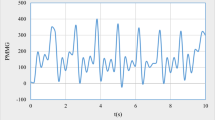Abstract
Sensors can be installed on various body parts to provide information for computer diagnosis to identify the current body state. However, as human posture is subject to gravity, the direction of the force on each limb differs. For example, the directions of gravitational force on legs and trunk differ. In addition, each person’s height and structure of limbs differs, hence, the acceleration and rotation resulted from such differences on force and length of the limbs of a person in motion would be different, and be presented by cases of different postures. Thus, how to present body postures through skeleton system equations, and achieve an long-term physical rehabilitation, according to the different limb characteristics of each person, is a challenging research issue. This paper proposes a novel scheme named as “Intelligent Body Posture Analysis Model”, which uses multiple acceleration sensors and gyroscopes to detect body motion patterns. The effectiveness of the proposed scheme is proved by conducting a large number of practical experiments and tests.





















Similar content being viewed by others
References
Zhang, Y., Grorec: A group-centric intelligent recommender system integrating social, mobile and big data technologies. IEEE Trans. Serv. Comput. 9(5):786–795, 2016.
Saxena, A., Sun, M., Ng, A. Y., Make3D: learning 3D scene structure from a single still image. IEEE Trans. Pattern Anal. Mach. Intell. 31(5):824–840, 2009.
Zhang, Y., et al., iDoctor: personalized and professionalized medical recommendations based on hybrid matrix factorization. Futur. Gener. Comput. Syst. 66:30–35, 2017.
Chen, M., Ma, Y., Song, J., Lai, C., Hu, B., Smart clothing: connecting human with clouds and big data for sustainable health monitoring. ACM/Springer Mob. Netw. Appl. 21(5):825–845, 2016.
Vlasic, D., Adelsberger, R., Vannucci, G., Barnwell, J., Gross, M., Matusik, W., Popovic, J., Practical motion capture in everyday surroundings. ACM Trans. Graph. (TOG) 26(3):35 , 2007.
Zhang, Y., et al.: Health-CPS: Healthcare Cyber-Physical System Assisted by Cloud and Big Data. IEEE Syst. J. doi:10.1109/JSYST.2015.2460747 (2015)
Ballan, L., and Cortelazzo, G. M.: Marker-Less motion capture of skinned models in a four camera set-up using optical flow and silhouettes. In: Proceedings of the Fourth International Symposium on 3D Data Processing, Visualization and Transmission, June 18–20, Atlanta, GA, USA (2008)
Wan, C. K., Yuan, B. Z., Miao, Z. J., Markerless human body motion capture using markov random field and dynamic graph cuts. The Vis. Comput. 24(5):373–380, 2008.
McNamara, J. E., Bruyant, P., Johnson, K., An assessment of a Low-Cost visual tracking system (VTS) to detect and compensate for patient motion during SPECT. IEEE Trans. Nucl. Sci. 55(3):992–998, 2008.
Li, B., Meng, Q., Holsteinc, H., Articulated motion reconstruction from feature points. Pattern Recogn. 41(1):418–431, 2008.
Ashutosh, S., Sung, H. C., Andrew, Y. N., 3-d depth reconstruction from a single still image. Int. J. Comput. Vis. 76(1):53–69, 2008.
Noah, S., Steven, M. S., Richard, S., Modeling the world from internet photo collections. Int. J. Comput. Vis. 80(2):189–210, 2008.
Zhang, Y., Chen, M., Mao, S., Hu, L., Leung, V., CAP: crowd activity prediction based on big data analysis. IEEE Netw. 28(4):52–57, 2014.
Zou, B., Chen, S., Shi, C., Providence, U. M., Automatic reconstruction of 3D human motion pose from uncalibrated monocular video sequences based on markerless human motion tracking. Pattern Recogn. 42(7): 1559–1571, 2008.
Jia, H., and Martinez, A. M., Low-rank matrix fitting based on subspace perturbation analysis with applications to structure from motion. IEEE Trans. Pattern Anal. Mach. Intell. 31(5):841–854, 2009.
Oliensis, J., and Hartley, R., Iterative extensions of the sturm/triggs algorithm: convergence and nonconvergence. IEEE Trans. Pattern Anal. Mach. Intell. 29(12):2217–2233, 2007.
Chen, H. T., Tien, M. C., Chen, Y. W., Tsai, W. J., Lee, S. Y., Physics-based ball tracking and 3D trajectory reconstruction with applications to shooting location estimation in basketball video. J. Vis. Commun. Image Represent. 20(3):204–216, 2008.
Chen, M., Hao, Y., Lai, C., Wu, D., Li, Y., Hwang, K.: Opportunistic workflow scheduling over co-located clouds in mobile environment. IEEE Trans. Serv. Comput. doi:10.1109/TSC.2016.2589247(2016)
Zhuxin, D., Wejinya, U. C., Shengli, Z., Qing, S., Li, W. J.: Real-time written-character recognition using MEMS motion sensors: calibration and experimental results. In: Proceedings of the IEEE International Conference on Robotics and Biomimetics, Feb. 22–25, Bangkok Thailand (2009)
Tseng, Y. C., Wu, C. H., Wu, F. J.: A wireless human motion capturing system for home rehabilitation. In: Proceedings of the Tenth International Conference on Mobile Data Management: Systems, Services and Middleware, May 18–20, Taipei, Taiwan (2009)
Liang, X., Li, Q., Zhang, X., Zhang, S., Geng, W., Performance-driven motion choreographing with accelerometers. Comput. Animat. Virtual Worlds 20(2-3):89–99, 2009.
Amasay, T., Zodrow, K., Kincl, L., Hess, J., Karduna, A., Validation of tri-axial accelerometer for the calculation of elevation angles. Int. J. Ind. Ergon. 39(5):783–789, 2009.
Huang, Q., Bian, G. B., Duan, X. G., Zhao, H. H., Liang, P., An ultrasound-directed robotic system for microwave ablation of liver cancer. Robotica 28(2):209–214, 2008.
Isola, A., Ziegler, A., Schafer, D., Kohler, T., Niessen, W., Grass, M., Motion compensated iterative reconstruction of a region of interest in cardiac cone-beam CT. Comput. Med. Imaging Graph. 34(2):149–159, 2010.
Catapano, I., Crocco, L., D’Urso, M., Isernia, T., 3D microwave imaging via preliminary support reconstruction: testing on the fresnel 2008 database. Inverse Probl. 25(4):024002–024025, 2009.
Garcia, J., Besada, J. A., Soto, A., Miguel, G. D., Opportunity trajectory reconstruction techniques for evaluation of ATC systems. Int. J. Microw. Wirel. Technol. 1:231–238, 2009.
Daniel, F. T., Gabriel, T., Stephen, P., Wavefront reconstruction of elevation circular synthetic aperture radar imagery using a cylindrical green’s function. EURASIP Journal on Advances in Signal Processing (2009)
Author information
Authors and Affiliations
Corresponding author
Additional information
This article is part of the Topical Collection on Mobile & Wireless Health.
Rights and permissions
About this article
Cite this article
Lai, CF., Hwang, RH. & Lai, YH. An Intelligent Body Posture Analysis Model Using Multi-Sensors for Long-Term Physical Rehabilitation. J Med Syst 41, 71 (2017). https://doi.org/10.1007/s10916-017-0708-5
Received:
Accepted:
Published:
DOI: https://doi.org/10.1007/s10916-017-0708-5




